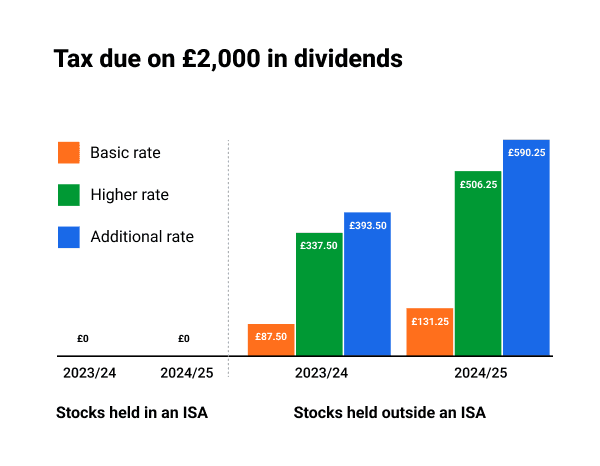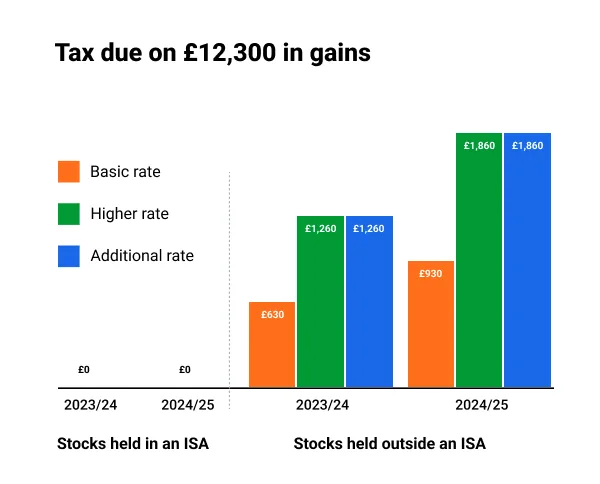
Learn more
The past couple of years have been turbulent for investors, to say the least. But while global uncertainty continues, some things remain certain – and taxes are famously on that list. So here’s what you need to know about some major changes to tax that start in 2023, and how to make the most of some tax-free options.

You might have used up this year’s £20,000 ISA allowance – the amount you can invest each year in ISAs – or you may be holding all your shares outside an ISA. Either way, there are changes coming that could affect you.
There are 2 major tax changes that this guide will explain: they affect dividends, and also profits from selling shares held outside a stocks and shares ISA.
Firstly, there will be a major cut in the tax-free allowance for dividend income. Until 6 April, 2023, there’s no tax to pay on up to £2,000 you get in dividends during the tax year. But on that day, the allowance drops to £1,000 and in April 2024, to £500.
The dividend tax-free allowance has been £2,000 for the past 5 years and that’s been enough to cover many people’s dividend income. But the changes will see more investors starting to pay tax on their dividends. HMRC estimates that the measure will affect more than 3 million people in 2023-24, and nearly 4.5 million the following year.
Secondly, a huge change is coming to the capital gains tax (CGT) tax-free allowance. If you made £12,300 of profit from selling shares during the year ending 5 April, 2023, this would be exempt from CGT (assuming you hadn’t made gains from selling other assets like art or a second property during the tax year).
But as of 6 April, there’d be tax to pay on around half that profit. That’s because the CGT annual tax-free allowance will be sliced in half from £12,300 to £6,000, and then halved again the following April from £6,000 to £3,000.
Of course tax is complex and everyone should get their own advice about legitimate ways to bring down a tax bill, such as offsetting losses, but many people will be impacted by these drops in allowances.
The changes underline how important ISAs are for investors. In the scenarios described above, under current tax rules you’d pay zero dividend tax or CGT if those shares were held in a stocks and shares ISA.
“Taxable dividend income excludes, for example, dividend income from assets held in ISAs, which will continue to be entirely tax-free.”
– HMRC website, March 2023
We could see investors putting on a sprint to use up their £20,000 annual ISA allowance before the April deadline, but ISAs in general may also become even more popular in the coming months as the Treasury’s changes come into force.
It’s worth noting that CGT and dividend tax in Scotland are calculated on the UK income tax thresholds, not the Scottish income tax bands.
To see what this means in practice for shares that aren’t held in an ISA, let’s say you’re a basic-rate taxpayer and you earn £2,000 in dividends before April 6, 2023. You’d pay no tax on that. But if you got the same £2,000 after that date, you’d pay £87.50 and in the following tax year, it would be £131.25.
For a higher rate taxpayer, the figure would be £337.50 in 2023-24, and £506.25 in 2024-25. And for an additional rate taxpayer, it’s £393.50 and then £590.25.

CGT applies to profits you make when you sell assets, which includes shares that aren’t held in an ISA. In the tax year ending 5 April, 2023, you could make £12,300 in gains (profit) tax free.
For the tax year 2023-24, basic rate taxpayers will pay tax of £630 on that same £12,300 profit from shares sold. And higher or additional rate taxpayers will pay £1,260.
For the following tax year, 2024-25, the figure for basic rate taxpayers jumps to £930 of tax on the same £12,300 profit from shares. And higher or additional rate tax-payers will both pay £1,860.

These rates apply for 2022-23 and 2023-24. The rate of tax you pay will depend on which income tax band you’re in – basic, higher or additional.
| Tax | Basic rate % | Higher rate % | Additional rate % |
|---|---|---|---|
| Stamp duty (on shares bought electronically) | 0.5 | 0.5 | 0.5 |
| Dividend tax | 8.75 | 33.75 | 39.35 |
| Capital gains tax | 10 (18 for property) | 20 (28 for property) | 20 (28 for property) |
It’s easy to think of ISAs as totally tax free – they’re often described as “tax wrappers”. And while this is true for dividend tax and CGT, the taxman has left a little corner of the gift unwrapped. HMRC gets a small percentage of your money through stamp duty, which is a 0.5% tax that you usually pay each time you buy shares.
Big changes are coming for investors both this year and in 2024. The changes make it even more crucial to take full advantage of tax-free allowances and the “shielding” that stocks and shares ISAs offer. If you’re thinking of getting a stocks and shares ISA, it’s key to compare and find the right one that will work for your investing strategy.
All investing should be regarded as longer term. The value of your investments can go up and down, and you may get back less than you invest. Past performance is no guarantee of future results. If you’re not sure which investments are right for you, please seek out a financial adviser. Capital at risk.
Thinking of expanding your investment portfolio overseas? Make sure you understand the tax rules for overseas investments.
Find out how dividend tax works, your allowances and bills you should expect to pay if you receive dividends.
Want to know what capital gains tax is, how it works and when you need to pay it? Read our comprehensive guide on what you need to know about capital gains tax including what your CGT allowance is for the 2024/2025 tax year.
Trading US stocks? Find out what the W-8BEN form is, how you need to fill it out with your broker and what it’s for.